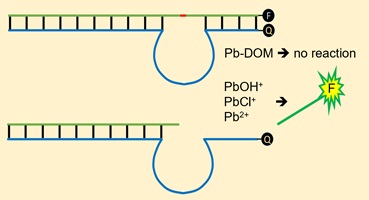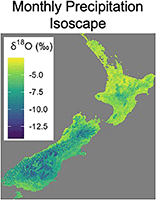Environmental context. The on-site and real-time detection of metal ions is important for environmental monitoring and risk assessment. For appropriate management decisions, it is necessary to specifically sense the labile fraction of metal rather than total metal. This study provides a proof-of-principle that the DNAzyme GR5 can be used to sense labile lead in natural waters containing dissolved organic matter. (Image credit: D. Scott Smith.)

Environmental Chemistry
Volume 22 Number 3 2025
Environmental context. Stable water isotopes δ18O and δ2H in atmospheric precipitation are valuable hydrologic tracers with varied applications, but measuring them over large scales is impractical. Precipitation isotope models (isoscapes) are instead needed to predict isotopes through space and time. Precipitation isotopes are affected by numerous variables ranging from orographic effects to phase changes to moisture mass origin, making them challenging to predict in complex geographies such as New Zealand. Improving data density together with recent advances in modelling approaches hold promise for improving accuracy of precipitation isoscapes in New Zealand and similar locations. (Image credit: Alice Hill.)
EN24098 Abstract | EN24098 Full Text | EN24098PDF (1.7 MB) | EN24098Supplementary Material (2.1 MB) Open Access Article
Environmental context. Unprecedented modification of the global nitrogen cycle by human activity is strongly imprinted in UK lakes by the changing abundance of nitrogen isotopes found in layers of lake sediment. UK lakes in the last century have responded to this change depending on their location, particularly if they are remote and occur above ~300-m altitude. Historical sediment nitrogen isotope data illustrate the impact of variable N sources on UK lakes, from fossil fuel combustion, synthetic fertilisers, to land use change and wastewater.
This article belongs to the collection: Dedication to Prof. Edward Tipping.






